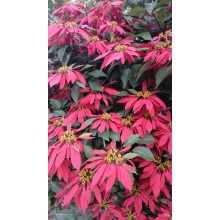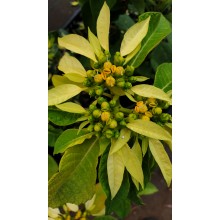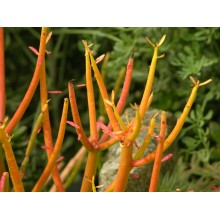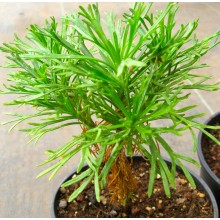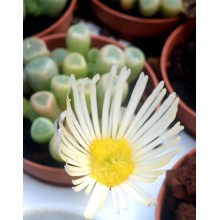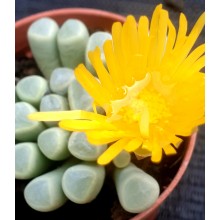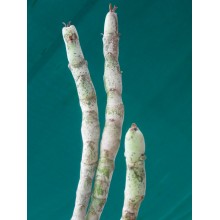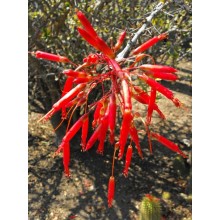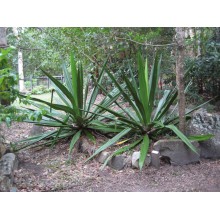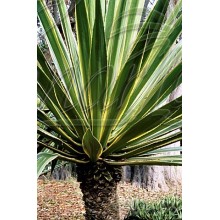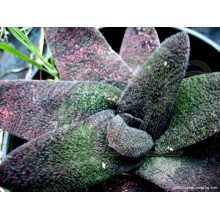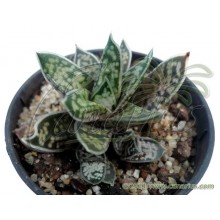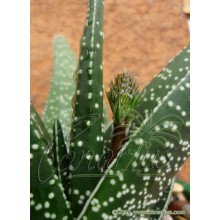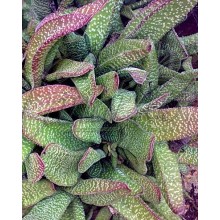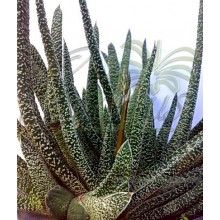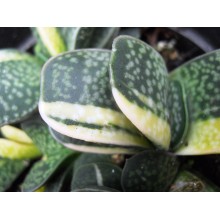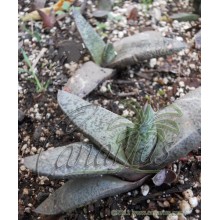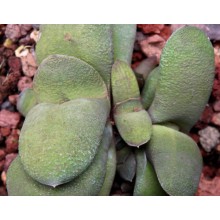Succulente Ci sono 628 prodotti.

I deserti del mondo e le zone secche ospitano le piante più interessanti. Canarius offre una selezione crescente di piante succulente di massima qualità, perché sono coltivate all'aperto, in pieno sole delle Isole Canarie.
I succulente o "piante grasse" sono specie di ritenzione di acqua, adattate alle condizioni di asciutto. Loro accumulano succum (succo, acqua) nelle loro foglie, steli o radici, e spesso mostrano un aspetto robusto e carnoso.
Sotto-categorie
-
Agave
Agave è un genere di piante grasse provenienti dall'America. Alcune specie crescono in zone fredde e possono sopportare un forte gelo, mentre altri vivono in climi tropicali. Alcuni sono piccoli nani e alcuni sono giganti, fino a 2 o 3 m di larghezza.
Le agavi resistenti al freddo possono creare un effetto esotico nel vostro giardino. Le specie agave fanno bella compagna di palme o cactus. Le agavi variegate sono incredibilmente ricercati dai collezionisti. Il nostro negozio web offre una selezione in continua evoluzione delle specie. Spediamo piante a radice nuda, se non diversamente specificato.
-
Aloe, Gasteria & Haworthia
Aloe, Gasteria e Haworthia sono tre generi correlate, comprese centinaia di piante succulente. Sono tutti facilmente coltivate in vaso. Alcuni si adattano a bassi livelli di luce di condizioni interne e possono essere coltivate come piante da appartamento.
- Aloe è un genere di circa 400 specie, originarie di Africa, Arabia e Madagascar. I aloe piccoli o nani stanno diventando particolarmente popolare in climi più freddi in quanto possono essere presi in casa durante i mesi più duri.
- Gasteria comprende circa 80 specie endemiche in Sud Africa, conosciuti per le loro foglie spettacolari che sono lucide, screziati e ruvidi. Fioriscono in primavera-estate con lunghe punte di piccoli fiori arancioni. Alcune specie sono talmente variabile che offriamo cloni particolari di località specifiche.
- Haworthia è un genere endemico in Sud Africa con circa 70 specie e un certo numero di sottospecie locali, varietà e forme. Le foglie sono spesso banded, punteggiati, punteggiato, o semi-trasparente e mostrano ampie variazioni.
-
Crassule
Questa è una nuova e crescente sezione di specie della famiglia Crassulaceae. Ci sono circa 1.400 specie in 33 generi et la loro distribuzione è in tutto il mondo, ma si presentano più nell'emisfero Nord e Sud Africa, in particolare in ambienti asciutti. Qui si possono acquistare piante sani, indurito dal sole, coltivati nelle isole Canarie e spediti a casa tua.
-
Mesembriantemi
Questo gruppo di piante del deserto è chiamato Mesembriantemi perché appartengono a una famiglia botanica precedentemente denominata Mesembryanthemaceae. Ci sono quasi 2.000 specie, che si trovano principalmente in Africa del sud, con adattamenti estremi agli habitat secco. Alcuni sono chiamati "pietre vive", perché sembrano come ciottoli. Molti sono facili da coltivare e il loro bisogno principale è pieno sole. Alcuni sono difficili perché crescono nelle aree veramente estreme.
Il nostro Web Shop offriamo piante sane coltivate al sole, con foglie compatte e colorate. Alcune piante sono venduti come talee, e altri come piante radicate, di almeno due anni. -
Sansevieria
Recentemente assegnato alla famiglia Asparagaceae, il genere Sansevieria conta circa 70 specie, quasi tutti nativi in Africa, Arabia e Madagascar. Erbe perenni adatti per gli habitat secchi con foglie rigide, succulente, la loro lunghezza varia da pochi centimetri a 2 metri. Sansevieria trifasciata e le sue numerose cultivar sono tra le piante d'appartamento più apprezzati, popolarmente chiamata la lingua di suocera. Una pianta ben coltivata di solito produce un picco di molti fiori bianchi, riccamente profumati e poi bacche arancioni. Anche le specie più rare sono resistenti ad abbandono, a condizione di tenerli dal gelo in inverno e sole cocente in estate.
-
Hoya
Le Hoyas sono rampicanti, dai fiori esotici e spesso vistosi. Provengono dalle foreste pluviali in Asia e Oceania. La maggior parte delle specie vive bene a mezz' ombra e si adatanno a vivere in casa come piante da appartamento. Sono ideali per cesti e tralicci. Tollerano un paio di settimane di siccità, ma sono sensibili al gelo e freddo. Molte hoya i sono facili da far crescere e fiorire, mentre alcune sono difficili e rare.
-
Asclepiadaceae
Le Asclepiade, o Asclepiadoideae, sono una sottofamiglia delle Apocynaceae, che annoverano circa 2900 specie diverse. Tra queste si trovano molti fusti privi di foglie ma anche erbe perenni, arbsuti, liane e, raramente, alberi. Producono fiori molto belli, dato il complesso sistema di impollinazione. Molte specie producono un odore insolito, spesso associato a quello di una carogna, la cui funzione è quella di attrarre le mosche che poi andranno a impollinare i fiori. -
Caudiciformi
Queste piante, dette anche pachicauli, sono tipiche delle zone aride. Producono un tronco insolitamente grosso e sproporzionato, detto caudice (a volte anche tubero), spesso con ramificazioni. Il caudice può essere anche nascosto sottoterra, ma nella maggior parte dei casi ha sviluppo verso l'alto, dando luogo ad alberi dalla forma spettacolare. I caudiciformi più grandi sono i baobab. -
Altre succulente
Qui troverete tutte quelle specie di piante del deserto che non sono inclusi nella propria categoria. Metteremo qui tutte le piante provenienti da famiglie inusuali, diversi da Agavi, Aloe, Crassulaceae, Sansevieria, Mesembriantemi, Epiphytic cacti, etc.
-
Euphorbia pulcherrima 'Tall Wild Type'
Euphorbia pulcherrima 'Tall Wild Type'
This is the most classic tall heirloom poinsettia which is so widespread in the old gardens of the Canary Islands and the Southern Mediterranean.
24,50 € -
Euphorbia pulcherrima 'Tall Wild Type' YELLOW
Euphorbia pulcherrima 'Tall Wild Type' YELLOW
This is the most classic tall heirloom poinsettia which is so widespread in the old gardens of the Canary Islands and the Southern Mediterranean.
24,50 € -
Euphorbia tirucalli 'Sticks on fire'
Euphorbia tirucalli 'Sticks on fire'
Elegant ornamental super-spiny palm with arching leaves that are glossy and dark-green above and silvery below.
45,00 € -
Euryops socotranus
Euryops socotranus
Rarely cultivated shrub endemic to the island of Socotra. It grows in rocky harsh areas and it is especially abundant at about 1000 m elevation. It is closely related to Euryops arabicus and thrives in coastal Mediterranean conditions. It is suited to pot culture and also makes a nice garden subject for dry sunny areas.
27,50 € -
Fenestraria rhopalophylla - White
Fenestraria rhopalophylla - White
Miniature beauty from South Africa. This succulent has unusual leaves with a translucent window on the top. Beautiful, white, daisy-like flowers. Easy to grow in sand, better with a winter rest.
10,30 € -
Fenestraria rhopalophylla ssp aurantiaca
Fenestraria rhopalophylla ssp aurantiaca
Cont. 6 cm. A beauty from South Africa. This succulent has unusual leaves with a translucent window on the top. Beautiful daisy like flowers. Easy to grow, needs a winter rest.
10,50 € -
Folotsia floribunda
Folotsia floribunda
2 year old seedling, H:20 cm. This Folotsia or Cynanchum looks quite different from those that are around. The thick stems are surely attractive because of their beautiful mottling.
23,00 € -
Fouquieria macdougalii
Fouquieria macdougalii
Succulent shrub from Sonora in Mexico, with arching branches and showy orange-red blooming. It grows well in cultivation and when co nstrained in a pot, it forms a nice short shrub with a caudex and will also bloom.
38,40 € -
Furcraea gigantea
Furcraea gigantea
Beautiful glossy green spineless Furcraea, native to Northern South America. The beautiful large rosettes attain 2 m in mediterranean conditions and almost 4 m in tropical climates. As most other furcraeas, it will stay small and stable forever if kept in pots.
16,50 € -
Furcraea selloa marginata
Furcraea selloa marginata
Stiff, glossy leaves, with golden margins. It is a variegated selection, traditionally planted in gardens of the Canary Islands. This elegant plant usually grows an aerial trunk of 0,5-2 m and then produces an incredibly tall inflorescence.
18,70 € -
Gasteria batesiana Pongola Poort
Gasteria batesiana Pongola Poort
Spectacular form with unreal colours. Leaves are mottled, dark green-pink-grey, covered by shiny bumps. Colour changes through seasons, according to light exposure.
16,00 € -
Gasteria bicolor var. liliputana
Gasteria bicolor var. liliputana
Cont.= 6 cm. One of the smallest gasterias. Clumping rosettes of 4-10 cm. Beautifully spotted leaves turn partially orange in full sun. It is a rare endemic from the Grahamstown quartzitic mountain range. Easy and suitable for indoor growing.
10,70 € -
Gasteria carinata
Gasteria carinata
Cont.= 6 cm. Medium sized species. Leaves are spotted in dark transverse bands. Margins are leathery, with small rounded teeth. It is native to the dry fynbos vegetation of the inland Western Cape. Thrives in Mediterranean climates.
10,70 € -
Gasteria carinata var. carinata
Gasteria carinata var. carinata
NEW ! - Rooted plant, h=8-10 cm. Leaves have a distinct keel and are densely dotted with small white tubercles. This Gasteria is a hardy plant for Mediterranean climates and can stand short freezes.
10,40 € -
Gasteria carinata var. verrucosa
Gasteria carinata var. verrucosa
NEW ! - Rooted plant, h=10-12 cm. Variable subspecies. Leaves have abundant pearl-white tubercles. It is possibly the cold hardiest species in the genus Gasteria as it can withstand temperatures down to -7º C
10,90 € -
Gasteria cv. Variegata
Gasteria cv. Variegata
We offer a clump of three-to-four heads of a nice, easy growing small and distichous gasteria
10,80 € -
Gasteria glauca
Gasteria glauca
A miniature silvery-grey species with a compact, distichous rosette of spotted leaves. Leaves are almost white, with dark green spots! This is the clone EVJ 14670, originally collected by the Kouga river, East of Guernakop, in the Eastern of South Africa.
10,20 € -
Gasteria glomerata
Gasteria glomerata
Nice dwarf species with immaculate, bluish leaves, arranged distichously (in two rows). It starts as a small flat lying plant and eventually grows into dome-shaped clumps.
10,40 €
Al momento ci sono pochi prodotti in questa categoria Succulente

























